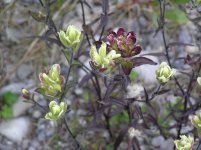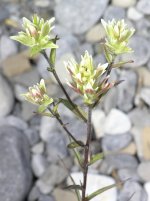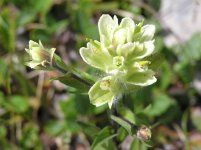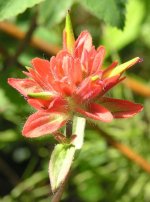steve_nova said:
This is not a typical flower
Steve -
I see what you mean -- you are saying the complex stuff in the middle is multiple stamens formed into petals, as in a garden double rose. However, I think they are actually small normal or near-normal flowers, and what appear at first sight to be the larger petals are actually bracts.
Looking at the further of the two flowering spikes, we have rounded purple petal-like objects in a pine-cone arrangement. These are the bracts -- you can see them becoming a little more leaf-like lower down (for non-botanists, a bract is a leaf with a flower in its axil, sometimes leaf-like, but often scale-like or petal-like -- think for example of the scarlet "petals" of the Poinsettia house-plant,
Euphorbia pulcherrima).
Above each bract is a flower, with the petals fused into a tube, teeth at the lip representing the petal tips. It is not very clear in the picture, but I think the sepals are also fused into a tube with long pointed teeth (look particularly at the left-hand flower of the further spike, where the lower part of the flower tube can be seen to be green and hairy).
The nearer spike is slightly out of focus, but the flowers clearly show stamens (and perhaps styles) protruding from the petal tubes.
The nearer spike is growing from a leaf (or bract) axil of the further one, and so it must be younger and at a slightly earlier stage. You can see some gone-over flowers between the lower bracts of the further one. I think that on the older spike the stamens and stigmas have shrivelled away, and stronger colour has developed at the same time.
As I don't know the species I can't comment on whether the flowers are abortive or deformed. I suspect not though, as many plants with strongly coloured bracts do have very small and inconspicuous flowers (as in Poinsettia).
Most of the Scrophulariaceae have strongly bilaterally symmetrical (zygomorphic) flowers, which this doesn't. However, it could be that this is a species (or aberrant individual) with rather rudimentary flowers, and such flowers do tend to look more radially symmetrical (actinomorphic -- star-shaped). The rest of the plant seems to match that family, though it would also be consistent with many other families.
I agree that bird's-beak,
Cordylanthus, does look superficially similar (and it is a Scroph), but my guess is it's not similar enough -- this plant does not have the "birds-beak" pointy flower shape.
It's also quite like mint family (Labiatae or Lamiaceae), but these usually (always?) have opposite leaves which this does not seem to have, so I think it's not one of those either.
Indian paintbrushes,
Castilleja, fit in some ways. They are Scrophs and they have colourful bracts with smallish less-conspicuous flowers -- see for example
http://www.larkspurbooks.com/Scroph1.html. Apparently there are very many species. Not sure though -- the pictures I can find seem to have larger, more complex bracts.
After that I'm lost...
Richard









